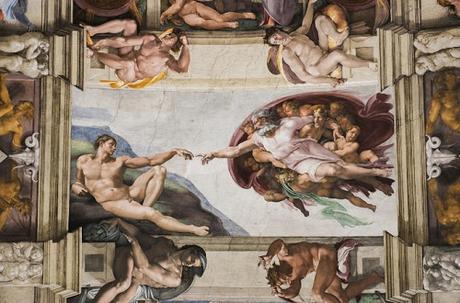
Inside the Sistine Chapel, you can find one of the most prominent pieces of art in the world. Michelangelo’s ceiling fresco is not only an impressive piece of art, but it also tells us a lot about the 16th Century, when it was painted.
It took the artist four years between 1508 and 1512 to finish the fresco, which represents a distinctive High Renaissance style that was very popular at the time.
The ceiling is the most famous part of the Sistine Chapel, which is located in the Vatican and is the largest papal chapel on the planet.
The fresco started life as an idea by Pope Julius II who had his heart set on Michelangelo doing the honours of painting it. But Michelangelo himself was initially very reluctant because he was a sculptor and not a painter.
But the persistence of Pope Julius II paid off because Michelangelo soon gave in and began work on the masterpiece.
How Michelangelo Painted the Chapel
It wasn’t an easy job for Michelangelo to do – which might be partly why he was reluctant to get started in the first place. The ceiling in the Sistine Chapel is particularly high, which meant that Michelangelo had to rig up his own customised scaffolding to reach every area. This scaffolding was made up of a wooden platform that was built out from the wall rather than from the floor up.
This meant that just half the inside of the Sistine Chapel was covered in scaffolding at any one time during the paint job, and it meant that Michelangelo could work on different sections until it came together as a whole. Even today, visitors can still see the faint marks of where the scaffolding was erected back in the 16th Century.
Because it is such a famous piece of art, there are obviously rumours flying around about its creation. Several stories say that Michelangelo painted the ceiling fresco while lying down, but that has since been proven to be not true. In fact, he painted it standing up.
He used the traditional “fresco” technique, which meant he applied the paint directly onto damp plaster, laying a new section of plaster to work on every single day. At the beginning of each fresh section, the artist would scrape the ages of plaster away – the marks of which visitors can see faintly see today.
For the actual painting part, Michelangelo used a specific kind of wash technique that meant he could put large areas of color down at once. Then, when the plaster started to dry, he could work in the details with finer lines.
Seeing Michelangelo’s finished masterpiece in the Sistine Chapel is the highlight of many visitor’s time in Rome – and for very good reason. It celebrates an important time in Roman history and showcases a range of traditional and important artistic techniques.
Advertisements
